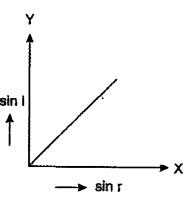For a lst order reaction , a straight line is obtained if you plot
log conc. vs time
conc. vs time
1/conc. vs time
log conc. vs 1/time
The correct Answer is:A
To solve the question regarding the plot for a first-order reaction, we can break it down into the following steps:
1. Understanding First-Order Reactions:
A first-order reaction is characterized by the rate of reaction being directly proportional to the concentration of one reactant. The general form of a first-order reaction can be represented as:
A→B
2. Rate Law for First-Order Reaction:
The rate law for a first-order reaction can be expressed as:
Rate=k(A)
where k is the rate constant and (A) is the concentration of reactant A.
3. Integrated Rate Equation:
The integrated rate equation for a first-order reaction is given by:
ln(Ct)=ln(C0)−kt
where:
- (Ct) is the concentration at time t,
- (C0) is the initial concentration,
- k is the rate constant,
- t is the time.
4. Rearranging the Equation:
Rearranging the integrated rate equation gives us:
ln(Ct)=−kt+ln(C0)
This equation is in the form of y=mx+b, where:
- y=ln(Ct)
- m=−k (the slope)
- x=t
- b=ln(C0) (the y-intercept)
5. Plotting the Graph:
When we plot ln(Ct) (y-axis) against time t (x-axis), we will obtain a straight line with a slope of −k. This indicates that for a first-order reaction, the plot of the natural logarithm of concentration versus time yields a straight line.
Conclusion:
For a first-order reaction, a straight line is obtained if you plot ln(Ct) versus time t.
---
A first-order reaction is characterized by the rate of reaction being directly proportional to the concentration of one reactant. The general form of a first-order reaction can be represented as:
A→B
The rate law for a first-order reaction can be expressed as:
Rate=k(A)
where k is the rate constant and (A) is the concentration of reactant A.
The integrated rate equation for a first-order reaction is given by:
ln(Ct)=ln(C0)−kt
where:
- (Ct) is the concentration at time t,
- (C0) is the initial concentration,
- k is the rate constant,
- t is the time.
Rearranging the integrated rate equation gives us:
ln(Ct)=−kt+ln(C0)
This equation is in the form of y=mx+b, where:
- y=ln(Ct)
- m=−k (the slope)
- x=t
- b=ln(C0) (the y-intercept)
When we plot ln(Ct) (y-axis) against time t (x-axis), we will obtain a straight line with a slope of −k. This indicates that for a first-order reaction, the plot of the natural logarithm of concentration versus time yields a straight line.
For a first-order reaction, a straight line is obtained if you plot ln(Ct) versus time t.
Topper's Solved these Questions
- CHEMICAL KINETICSBOOK - AAKASH INSTITUTECHAPTER - CHEMICAL KINETICSEXERCISE - ASSIGNMENT (SECTION B : Objective Type Questions)
20 Videos
- CHEMICAL KINETICSBOOK - AAKASH INSTITUTECHAPTER - CHEMICAL KINETICSEXERCISE - ASSIGNMENT (SECTION C : Previous Year Questions)
62 Videos
- CHEMICAL KINETICSBOOK - AAKASH INSTITUTECHAPTER - CHEMICAL KINETICSEXERCISE - EXERCISE
30 Videos
- CHEMICAL BONDING AND MOLECULAR STRUCTURE BOOK - AAKASH INSTITUTECHAPTER - CHEMICAL BONDING AND MOLECULAR STRUCTURE EXERCISE - Assignment Section J (Aakash Challengers Questions)
10 Videos
- CHEMISTRY IN EVERYDAY LIFE BOOK - AAKASH INSTITUTECHAPTER - CHEMISTRY IN EVERYDAY LIFE EXERCISE - Assignment ( SECTION - A)
45 Videos
Similar Questions
For a first order kinetics,a straight line is obtained by plotting dxdt against:
(A) a-x
(B) a+x
(C) log(a-x)
(D) initial concentration
View SolutionAccording to the Arrhenius equation a straight line is to be obtained by plotting the logarithm of the rate constant of a chemical reaction (logk) against
View Solution
Knowledge Check
For which order reaction a straight line is obtained along with x-axis by plotting a graph between half-life (t1/2) and initial concentration 'a'
A1B2C3D0For which order reaction a straight line is obtained along with x-axis by plotting a graph between half-life (t1/2) and initial concentration 'a'
A1B2C3D0When a ray of light undergoes refraction, a straight line graph is obtained by plotting sine of angle of incidence versus sine of angle of refraction. The slope of this graph represents.
 Avelocity of lightBrefractive indexCwavelength of lightDnone of these
Avelocity of lightBrefractive indexCwavelength of lightDnone of these
If a graph is plotted between ln k and 1/T for the first order reaction, the slope of the straight line so obtained is given by
View SolutionA plot of logarithm of rate vs logarithm of concentration of the reactant in a first order reaction is straight line whose slope is tanθ, where θ is
View SolutionAccording to Moseley, a straight line graph is obtained on plotting:
View SolutionAccording to Moseley, a straight line graph is obtained on plotting:
Where, v is frequency and Z is atomic number.
View Solution2NO2(g)→2NO(g)+O2(g) For the reaction above, a straight line for which plot indicates a second order reaction ?
View Solution
